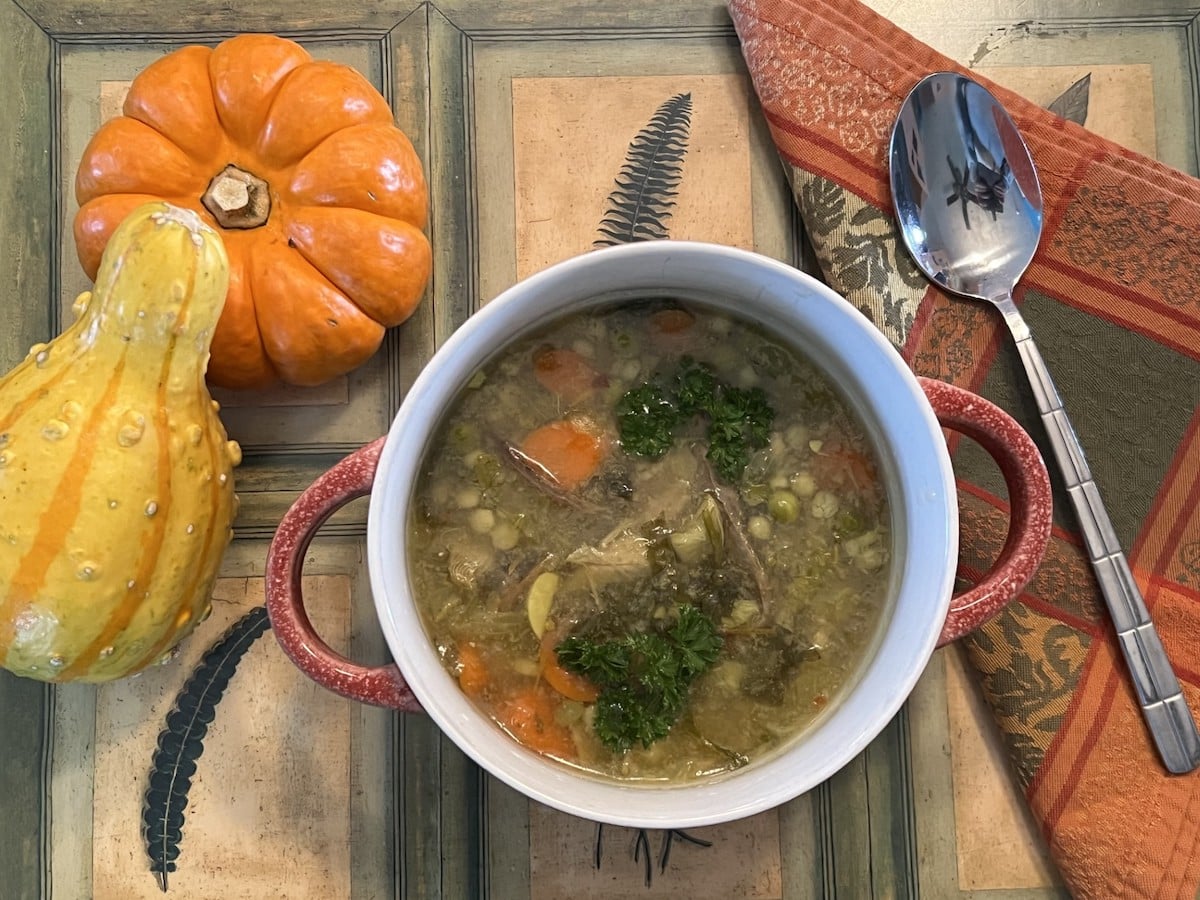
Share this post!
Welcome back to the next installment of the nutrients of the rainbow series. So far, we’ve covered the nutrients responsible for red, orange, and yellow, which include anthocyanins and carotenoids.
Next up is the color green. There aren’t many compounds that create the appearance of green in plants. In fact, there’s really only one nutrient that is responsible for this color and that is chlorophyll.
Chlorophyll is of the utmost importance to plants, and consequently to all animal and human life. We’ll learn about how this molecule’s role in harvesting energy from the sun, making life on Earth possible by producing food for the plant and the animals who eat them, while emitting a waste product with major biological significance – oxygen. Then, we’ll cover what happens when chlorophyll breaks down, other nutrients associated with green foods, and ways to get more green on your plate.
Chlorophyll: A Pigment Suited for Plant Energy
Plants, especially their leaves, appear green because of the pigment inside them named chlorophyll. A pigment is a molecule that has a particular color because it absorbs light at wavelengths of its complementary, or opposite, colors.
Basic Complementary Colors:
- Red and Green
- Orange and Blue
- Yellow and Purple
We’ve seen the benefits of this phenomenon in the ability of the orange-pigmented compounds, lutein and zeaxanthin, to absorb blue light to protect our eyes. Similarly, chlorophyll absorbs red wavelengths, so it appears green.
Sunlight, of course, contains all the wavelengths of the rainbow blended together. The various forms of chlorophyll, with some help from carotenoids, absorb light at wavelengths that correspond to red, but also blue. This helps the plant to balance its energy intake so it gets enough energy in times of low light and protects it from energy overload in times of too much light.
The following diagram illustrates the structures and wavelength absorption spectra of the two main types of chlorophyll and beta-carotene.

Notice that wavelengths corresponding to green and yellow are not absorbed. Reflecting these wavelengths is the reason plants are green.
Chlorophyll’s Structure
Chlorophyll contains two main chemical features. The first is a porphyrin ring, the circular portion of the chlorophyll structure in the diagram above. In the center of the porphyrin ring is a magnesium ion. Another well-known porphyrin structure is the heme unit of hemoglobin, which contains an iron atom at its center. Cobalamin, also known as vitamin B12, is another example with cobalt occupying the center of the ring.
Porphyrin rings have conjugated bonds that, as we learned in the previous rainbow blogs, give these molecules the energetic ability to absorb certain wavelengths to produce color. The metal ion in the center adds another dimension to the molecule’s light absorption capacity. Heme is red, chlorophyll is green – the electron interactions between conjugated bonds and the metal center determines which color is seen.

The other structural feature of chlorophyll is the long carbon chain attached, known as a phytyl chain. This feature stabilizes the chlorophyll molecule and makes it soluble in fat. The porphyrin part of chlorophyll is soluble in water.
In plants, chlorophyll is bound to protein structures used in photosynthesis. Once these bonds are broken, chlorophyll loses a lot of stability. This molecule is very sensitive to all kinds of environmental stimuli, like light, acidity, high temperature, enzyme degradation, and oxygen. Think about the discoloration of cucumbers as they are pickled in vinegar, for example.
Chlorophyllin, a common supplemental form of chlorophyll, derives from the natural structure above minus the phytyl chain, making this somewhat synthetic version soluble in water. The magnesium ion at the center is often replaced with copper or zinc, which protects it from degradation and loss of its vibrant green color.
There are 5 main forms of chlorophyll: a, b, c, d, and f. Chlorophyll a is the most abundant variety. It is present in any organism that performs photosynthesis.
Chlorophyll’s Function
There are two main benefits of chlorophyll to plants and the rest of the ecosystem on planet Earth. The first is photosynthesis, which gives plants the ability to provide food from themselves using carbon dioxide, water, and sunlight.
Chlorophyll is found in the chloroplasts, the cells of a plant where photosynthesis takes place. In photosynthesis, the plant uses light from the sun and translates it into energy. Chlorophyll’s role is to absorb light for this purpose. The energy is then used to make food for the plant.
The second benefit is the byproduct of photosynthesis, oxygen, which is essential for animal life.
In a nutshell, all life is dependent on chlorophyll. It is essential for the nutrition of plants, the animals who eat plants, and the animals who eat other animals who eat plants. Furthermore, without oxygen, we would perish pretty quickly. One could say this special green molecule is a pretty big deal.
Degrading Chlorophyll Reveals the Unseen Colors of Leaves
Few, if any, organisms can be energy makers all of the time, and plants eventually shut down their photosynthetic machinery to succumb to the cycle of life and death. As a result, chlorophyll naturally degrades.
There is no better display of this phenomenon than the coloring of leaves in the fall. As sunlight wanes, plants shut down chlorophyll production and the action of an enzyme, chlorophyllase, begins to take over.
Chlorophyllase breaks the bond between the porphyrin ring and the phytyl chain and the chlorophyll molecule degrades and loses its function. This gives the unseen nutrients of the rainbow, carotenoids and anthocyanins, the opportunity to shine their brilliant yellow, orange, and red hues, as they are no longer masked by the power of chlorophyll.
Not only are decomposing leaves the result of degrading chlorophyll, ripening fruit is another example. When fruit is ready for ripening, the plant begins to emit a gas called ethylene. Ethylene stimulates the production of chlorophyllase, which degrades chlorophyll and allows the true color of the fruit to shine. This is happening when your bananas turn from green to yellow and tomatoes from green to red.
We now know that chlorophyll makes energy and oxygen production possible in plants, but what about its nutritive value?
Nutritional Benefits of Chlorophyll
Chlorophyll supplementation is one of the latest trends in holistic nutrition, claiming benefits including antioxidant activity, binding to carcinogenic substances, and increasing energy. Many supplements contain the semi-synthetic, water-soluble version discussed earlier, chlorophyllin.
Preparations of chlorophyllin are used topically on wounds and acne. It has also been used for many decades as an “internal deodorant”, often for colostomy patients, to improve the odor of urine and feces.
More research is definitely needed to ascertain the purported metabolic and anticancer benefits of chlorophyll supplements, as the bioavailability and mechanisms of this nutrient are not well known.
Though the nutritive benefits of chlorophyll supplementation are unclear, consuming plenty of green vegetables and fruits has plenty of other benefits, especially in support of metabolic, cardiovascular, and cognitive health.
Other Nutrients in Green Plants
- Magnesium
- Potassium
- Folate
- Fiber
- Vitamin C
- Vitamin K
- Iron
- Carotenoids
- Nitrates

How to Get More Green on Your Plate
Eat your veggies! Here are some suggestions that are especially high in chlorophyll.
- Spinach
- Kale
- Parsley
- Cress
- Green beans
- Arugula
- Leek
- Endive
- Sugar snap peas
- Green cabbage
- Celery
- Broccoli
Enjoy them in salads, smoothies, lightly steamed, or in soups. Add a side of my favorite green treat – homemade pickles!
Pickles Recipe
I’ve included two recipes for pickles. One is a basic dill pickle, and the other is a sweet variety. Normally I’m not a fan of sweet pickles, but I discovered this recipe as I was researching a cultivar that I grew in my garden last year, Boothby Blonde, and fell in love.
Boothby Blonde is actually a yellow variety of cucumber that is particularly suited for sweet pickling, though I’ve tried this recipe with green pickling cucumbers with great success. They are so delicious alongside pretty much any meal.
Basic Dill Pickle
Ingredients:
- 4-5 pickling cucumbers – about 5 cups thinly sliced
- ½ onion of your choice, thinly sliced (about one cup)
- 5 tbsp sea salt or pickling salt
- 2 garlic cloves, sliced
- 1 tsp mustard seeds
- Dill sprigs
- 1 tsp black peppercorns
- 1 cup water
- 1 cup white vinegar
- 2 tbsp sugar
Directions:
- Cover cucumbers and onion with salt and let sit for 1-2 hours.
- Meanwhile, bring water, vinegar, sugar, and peppercorns to boil. Simmer for 5 min, then remove from heat.
- Add garlic, mustard seeds, and dill to the pickle mixture and divide in glass jars. The seasonings can be customized to your preference as well.
- Strain liquid mixture and pour over jars evenly. Refrigerate and enjoy in 1-2 days.
Sweet Pickles
Ingredients:
- 4-5 pickling cucumbers, about 5 cups thinly sliced
- ½ onion of choice, thinly sliced (about one cup)
- 1 ½ tbsp sea salt or pickling salt
- 1/2 cup granulated sugar
- ¼ cup brown sugar
- 1 cup white vinegar
- ½ cup apple cider vinegar
- 2 tsp mustard seed
- 1 tsp celery seed
- ½ tsp turmeric
Directions:
- Cover cucumbers and onion with salt and let sit for 1-2 hours.
- Combine remaining ingredients, except apple cider vinegar, over medium heat and simmer to dissolve sugar – about 10 min. Remove from heat and add apple cider vinegar.
- Divide cucumber mixture among two quart sized glass jars. Pour liquid mixture evenly into the jars. Refrigerate and enjoy in 1-2 days.
Stay tuned for the final blog in the rainbow series: blue/purple. And remember, no matter what’s on your plate, be thankful for chlorophyll, the green molecule that makes the food we eat and the air we breathe possible.
_________________________________________________________________________________________________________________
About the author
Karyn Lane is working towards her holistic nutrition certification in NTI’s Nutrition Therapist Master Program. She finds her chemistry degree a useful tool in her study of holistic nutrition and loves to treat herself as a laboratory for new recipes and cooking techniques. You can follow her on Instagram @feel.alive.nourishment.
About Nutrition Therapy Institute’s Holistic Nutrition Certification
Nutrition Therapy Institute (NTI) is a leader in holistic nutrition education. Since 1999, NTI has provided students with the highest quality in nutrition training by offering comprehensive holistic nutrition courses online and in-person to help students achieve thriving careers as holistic nutrition therapists in the field of holistic nutrition counseling and wellness. Interested in starting our holistic nutrition courses and earning your holistic nutrition certification? Attend an informational webinar to learn more by signing up HERE.
Image:
Image by susnpics is free for use by Pixabay
Image by CNX OpenStax is licensed under CC BY-SA 3.0
Share this post!




















